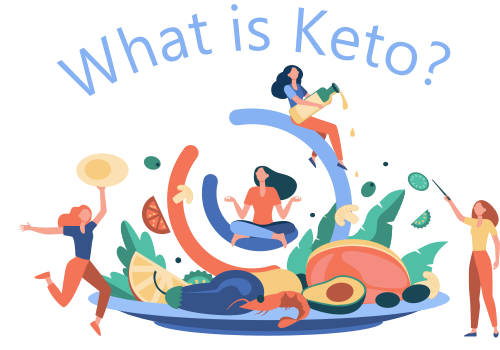Last week we discussed the Paleo way of eating. This week I would like to talk a bit about what a Keto diet is. By its definition, a keto diet (short for ketogenic) is any diet that puts your body into a state of ketosis. The dictionary definition of ketosis is: “a metabolic state characterized by raised levels of ketone bodies in the body tissues, which is typically pathological in conditions such as diabetes, or may be the consequence of a diet that is very low in carbohydrates”. The keto diet is typically a low carbohydrate, high fat, and moderate protein diet.
What is a ketone body?
When we burn fat, either the fat we eat or the fat stored on our bodies, it produces three different compounds that we call ketones. These are acetone, acetoacetate and beta-hydroxybutyric acid. These are the waste byproducts of fat burning. They indicate that we are no longer burning glucose for our energy, we have become fat burning machines. We can measure the levels of ketones in our body in several ways because these ketones are expelled through our breath and urine and are present in our blood. There are urine strips, breath analyzers and ketone blood meters for measuring these values. I recommend the ketone blood meter as it seems to be the most accurate way to get good readings.
How do I eat to get my body into ketosis?
In order for our bodies to enter into a state of ketosis, we must lower the carbohydrate intake and deplete the sugar stores we have in our body tissues. This allows our bodies to use fat for fuel. Our bodies were made to switch between fat and sugar metabolism as a means of survival. We eat: we store fat, we can’t eat: we burn fat. The problem is that we have access to so much processed, refined carbohydrate food now that we never see the famine stage of feast and famine. Our bodies have become overly dependent on carbohydrates for fuel and have stopped creating the necessary components that allow us to easily burn fat for fuel. We are no longer metabolically flexible. In order to become more metabolically flexible we need to reduce our carbohydrate intake and increase our fat intake. Many experts recommend no more than 20 grams of carbs each day in our daily diet, but each person is different and some can eat many more carbohydrates each day and maintain a state of ketosis. Some have set guidelines of 5% carbohydrate, 70% fat and 25% protein. For someone starting out, this might be a good place to start but don’t feel boxed in to these values. You have to find what is right for your body. You can do this by tracking your intake and measuring your ketones with a ketone meter.
The keto diet can be done in many ways. There are many processed food products on the market now that are “keto friendly”. You don’t have to look very far at the grocery store to find this buzzword. One way to “do” keto is often referred to as “lazy keto”. Lazy keto just means that if the carb, fat and protein ratios fit into your daily limits then go for it. You could eat a diet composed mostly of lettuce wrapped fast food burgers and you would end up in ketosis. Another way is a more nutrient dense, whole foods approach. This is where you are getting most of your carbohydrates from whole food sources of vegetables. It would be similar to the Paleo way of eating, but without most of the fruit and leaving out the higher carbohydrate starchy vegetables. This would be the best way to eat a ketogenic diet because you are focusing on nutrient dense foods. It is often referred to as “clean keto”.
When would I recommend it?
I would recommend a ketogenic diet to anyone looking to lose weight. This way of eating turns on the fat burning machine and allows the body to burn off the stored fat for fuel. This diet is also great for those that are experiencing food sensitivity problems, because it removes many of the common allergen foods from the diet. Many people find they feel so much better when they just cut out all the grains from their diet. This way of eating would also be great for anyone with blood sugar regulation problems.
I would recommend a clean keto diet. We need to make sure that we are meeting our nutrient needs with whole foods that are properly prepared. The foods we eat and absorb are the basis of our health. If we are eating nutrient dense foods and digesting them properly, then our cells will be stronger and healthier too.
The ketogenic diet is a healing diet that has been shown to be very effective at helping people to lose weight. I have seen many of my own health issues healed through this way of eating and have watched those around me heal their bodies also.
